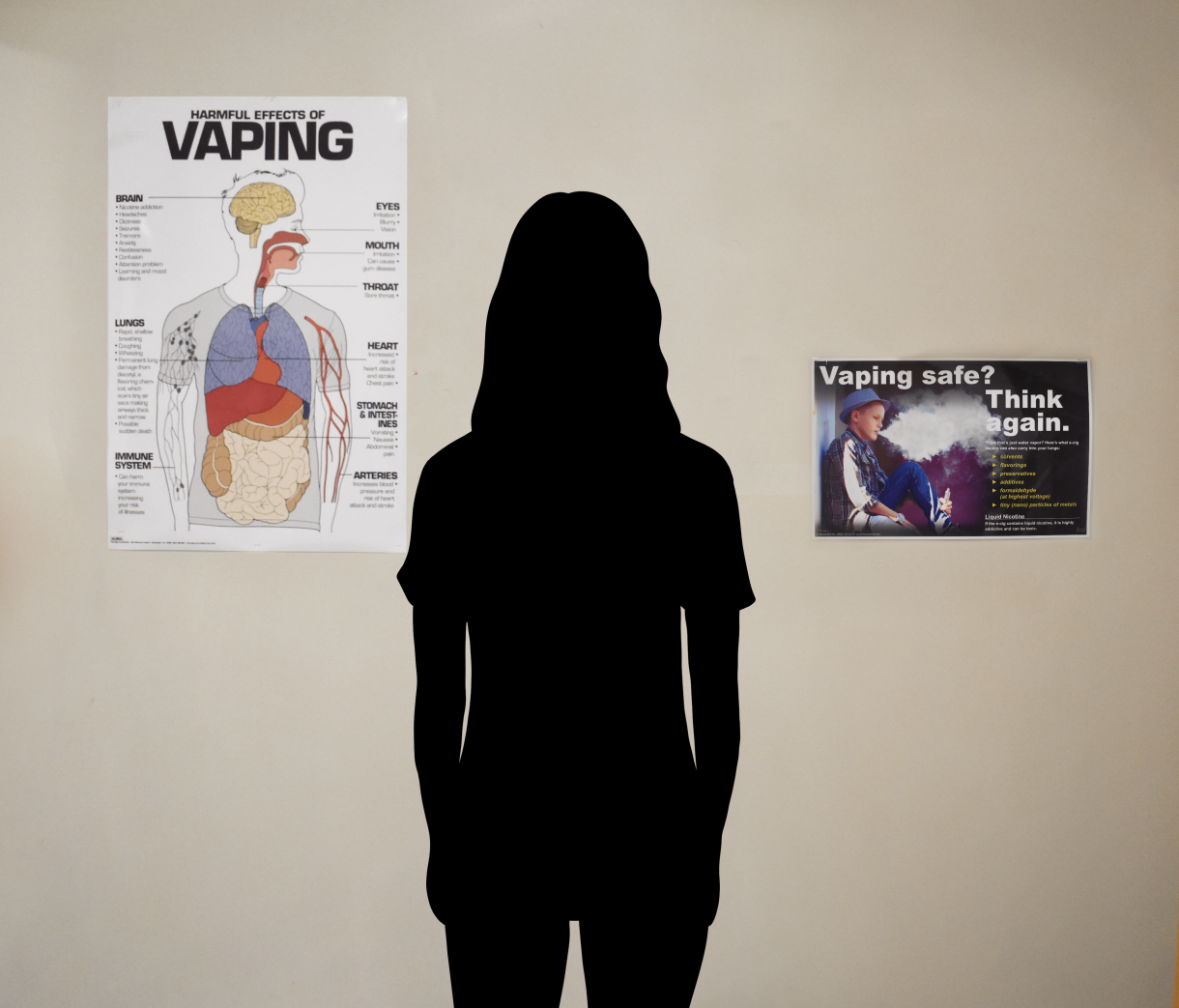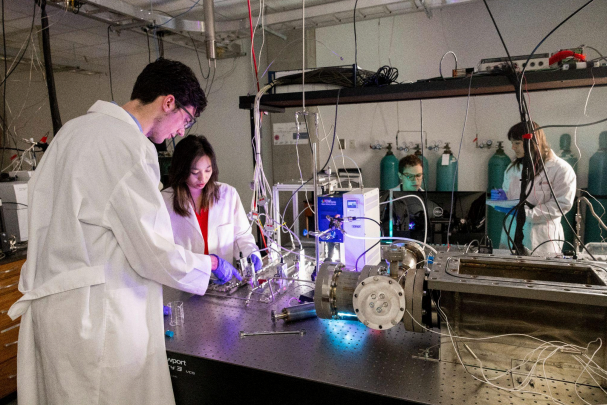Under the radar, over the limit; schools attempt to curb student vaping

DeKalb County Schools has implemented electronic device detectors in bathrooms and locker rooms, addressing a widespread trend of vaping in schools. Atlanta Public Schools is not currently using detection devices, but Midtown has been working to mitigate vaping.
During their freshman year, Midtown student Trudy Davidson* was offered an electronic cigarette by an upperclassman. Curious about the flavors and influenced by friends, Davidson said “yes.”
“It was a strange thing to experience,” Davidson said. “I felt like I was a monkey and people were watching me. There was a sophomore and a junior, and they were watching to see my reaction. Obviously, I didn’t do well the first time, and we all had a laugh about it.”
DeKalb County Schools recently decided to install vape detection devices in middle and high school bathrooms and locker rooms. Now an upperclassman, Davidson vapes daily, but supports measures to limit vaping.
“I don’t advocate for other people to start; I don’t think it’s a good thing,” Davidson said. “It’s nothing that high schoolers should be making the decision to start doing, so I mean [vape detectors are] a good thing because there’s no reason for high schoolers to have those devices anyway and it will probably be better for the community.”
These detection devices will allow staff to monitor vape usage remotely so they can intervene without invasive cameras.
“The vape detection devices will detect nicotine and THC aerosols and send instant alerts to designated staff when thresholds are met, allowing real-time intervention without compromising student privacy,” a spokesperson for DeKalb County Schools said.
DeKalb County Schools said that the reason for implementing the vape detectors is simple: they want to improve academics and the welfare of student’s health.
“Vaping among adolescents continues to rise at alarming rates,” the spokesperson said. “In the 22–23 academic year alone, Georgia reported over 22,000 vaping-related disciplinary incidents. Nationally, more than 1.6 million youth reported e-cigarette use in 2024, with 26.3% of those using daily. These behaviors not only pose a health risk but also create ongoing classroom disruptions and strain administrative resources.”
It is illegal for any person under age 21 to purchase a vape, so Davidson said underage students use three methods to get around the law.
“The first one is having someone outside of school, like a sister or brother or some college student who’s old enough that goes and buys you one from any convenience store, or the many shops around Atlanta,” Davidson said. “Another one is upperclassmen sometimes have fake IDs, and they will go and get one. And the third one is, there are specific stores around the metro Atlanta area that will sell you one and will not ask for an ID.”
Midtown student Tyrone Bradshaw,* is surrounded by friends that vape.
“It was weird at first because I was never exposed to vaping until high school,” Bradshaw said. “As time has passed, I don’t even notice it anymore.”

AP Psychology teacher Andrew Copeland has found that, similarly to smoking, vaping has gained popularity through social use at school.
“I’m sure back in my parents’ age and before that, smoking was this cool thing to do and people got started because everyone was doing it in school,” Copeland said. “We’ve seen that come back into favor with vaping, and even harder with the fact that it’s so concealable. In school, in the bathrooms, it’s your friends going and doing it. It becomes a social phenomenon of this thing that we all do together.”
Freshman year, Davidson said their friends said vaping helped them feel a sense of belonging as they transitioned to high school.
“They felt a sort of community with the upperclassmen, because the upperclassmen would give them tips and tricks on how to do different tricks with the smoke, or they would sell stuff to them or they would go and buy them for them,” Davidson said. “[Vaping] kind of creates a little strange community.”
Copeland said he sees nicotine addiction as a case of positive and negative reinforcement, leading to users’ dependence on vapes.
“Nicotine creates a pleasure response, you get a hit of dopamine,” Copeland said. “That is what leads to the addiction. You actually get a boost in attentiveness, focus and increase in blood pressure. It first becomes a sense of positive reinforcement because you have that pleasure from doing it, but now you feel bad or feel off because you’re not doing it and so then you do it to get rid of those negative symptoms.”
Cigarettes have been around long enough for extensive research on their health implications, but vaping was popularized during the 2010s, so there hasn’t been as much time for researchers to understand long-term effects. Pulmonary and critical care physician Dr. Douglas Haden cited concerns that vaping could lead to chronic obstructive pulmonary disease, which can cause chest tightness, wheezing, lack of energy, lung infections and more.
“In the short term, we know that young people who vape are much more likely to have difficulty with their asthma, chronic cough, chronic phlegm production and more episodes of bronchitis requiring treatment,” Dr. Haden said. “What we really don’t know, though, is what the long term ramifications are going to be. There are concerns that people will develop something called COPD, which is something that you can get from smoking combustible cigarettes.”
Copeland has seen friends struggle with nicotine addiction and try, often unsuccessfully, to quit.
“Most people in their lives, at some point, are going to want to quit nicotine,” Copeland said. “And when they get to that point, it’s going to be a very hard thing to do. As you use it longer, you increase your blood pressure, it hardens your arteries in your heart and makes you susceptible to heart issues. You’re just setting yourself up for long-term struggles.”
One cartridge of vape fluid can have as much nicotine as 600 cigarettes, and this potency can cause people who vape excessively and kids who accidentally drink vape fluid to get nicotine poisoning, sometimes resulting in death.
“The big things they worry about are the renormalization of smoking behavior, the gateway to ultimately using combustible cigarettes, nicotine dependence and risk for nicotine poisoning, which can be from just using it too much,” Dr. Haden said. “Rarely do people do that to themselves smoking cigarettes, but it’s easy to do with a vape.”
Bradshaw has tried vaping firsthand, but chose not to continue because of the possibility of addiction.
“I have tried vaping just because I was interested in what it felt like, but it has never been something I wanted to get into,” Bradshaw said. “I choose not to vape because of the addiction that I know it can take on people, as well as the health consequences, but mainly the addiction.”
Dr. Haden said there may be unknown risks to the aerosol ingredients in vapes that aren’t in combustible cigarettes.
“We don’t know the long term ramifications of the exposure to the aerosol components,” Dr. Haden said. “What we do know, though, is that if you heat up the fluids that are put into an e-cigarette, you produce things like formaldehyde, acetaldehyde and other things that we know are not good for you to be breathing in, but we don’t know what the actual concentrations will be yet.”
In 2019, EVALI, or E-cigarette or Vaping Product Use-Associated Lung Injury, was reported across the U.S., causing 68 deaths. The CDC found this was due to vitamin E acetate in the vape fluid, and a series of state bans and manufacturing changes ended the use of this additive. Dr. Haden is optimistic vaping won’t continue to cause severe disease.
“Back when there was the outbreak of really bad EVALI, I took care of one patient who was very sick and on a ventilator who ultimately survived,” Dr. Haden said. “Hopefully, the bulk of that really severe disease won’t happen again.”
School nurse Wanda Taylor has noticed students sneak vapes into her office bathroom.
Atlanta Public Schools does not currently plan to implement vape detection device across the district.
“Currently, Atlanta Public Schools does not have vape detection technology districtwide as it has not been a widespread issue in our schools,” the district said. “However, our school administrators and our safety and security team will continue to vigilantly monitor the situation and make adjustments if necessary.”
However, Taylor said detectors would be helpful.
“I used to work in a jail, so I see tricks,” Taylor said. “I see students want to come in my bathroom, because you could vape in my bathroom, I would never know because the vape doesn’t have an odor and if you’re in there you can [vape]. So if people take a little too long, I bam on the door and say ‘you want me to call the officer to help you come on out of here.’ The kids [will say] they really have to leave the classroom: ‘I have to go, I have to go right now,’ because they need to hit that vape. Some schools are having vape detectors, I wish they would get up here.”
Dr. Haden said youth are more likely than adults to share vapes, which can spread disease.
“Young people are commonly co-using cigarettes and electronic cigarettes, and that’s going to inevitably lead to an increase in respiratory symptoms,” Dr. Haden said.
Improper disposal of the lithium ion batteries in vapes can result in fires, chemical pollution and waste of valuable raw materials. Davidson said they save their vapes to dispose of them properly, but also recognizes that vaping has some unavoidable environmental consequences.
“I do keep all of my [vapes], and then at some point, once the bag I have gets too full, I’ll take it to an actual plant that you’re supposed to deliver all of them to so I can safely dispose of them in the correct way, so it doesn’t have a horrible environmental impact,” Davidson said. “I know obviously smoking in general is bad for air pollution, but I try and do the best I can.”

In previous years, Davidson said large circles of students would crowd the bathrooms, talking and sharing vapes. However, they’ve recently seen a decline in this behavior.
“Strangely enough, there’s kind of been a decrease, at least in the whole community thing I was talking about,” Davidson said. “There used to be genuinely big circles, like people would meet in bathrooms after certain periods, and there’d be a ton of people in there. I feel like last year it had definitely gone down.”
Davidson attributes this change to closer admin supervision over bathrooms.
“There haven’t been a lot of strict policies specifically to go against vaping,” Davidson said. “I think they put more admin outside of the bathrooms and have been checking to see if too many people are going in, because I know that was probably a big reason why this stuff kind of broke up, because admin would come in the bathrooms periodically and stand out in the open.”
However, Taylor said vaping is not gone from Midtown bathrooms. She suggests each teacher spends 10 minutes of their planning period to monitor the bathrooms and discourage students from vaping.
“We need bathroom monitors because that’s where the vaping is done,” Taylor said. “That’s where the drug use is done. How many times do I get requests to help children from the bathroom that have taken too much of something?”
Davidson said closer admin oversight has been successful in reducing vaping at Midtown, and they think vape detectors would help limit it as well.
“It would probably stop people from bringing [vapes] into school, in combination with people finding other ways to do it on campus,” Davidson said. “But I know definitely last year or the year before, when there were all those busts, like admin walking in and actually catching people, I definitely heard from a lot of people that they stopped bringing in their vapes for a month or two.”
A 2024 study by researchers at the University of Michigan found that among 12-17 year olds, those who vape are 54 times more likely to smoke cigarettes, eight times more likely to use marijuana and three times more likely to use other drugs. Davidson worries vape sensors could push students to explore more harmful drugs.
“If it’s vape sensors, then they can’t bring those into school– what else are they going to be doing in the bathroom?” Davidson said. “Addictive personalities aren’t always going to be addicted to one thing. So then I think about the increase in carts and the increase in actual hard drugs.”
*Represents sources who chose to remain anonymous



Fairlie Mercer is a senior and this is her third year writing for The Southerner. She currently serves as an Editor-in-Chief and is excited for her second year as an editor. Outside of journalism, she enjoys hanging out with friends and dance.






















